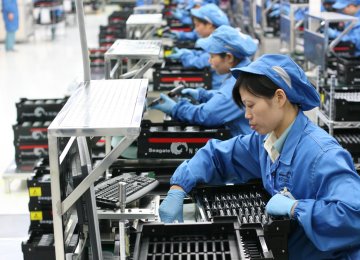As Chinese President Xi Jinping begins his second five-year term, shifting toward “quality growth” is at the top of the country’s policy agenda. Across China’s government, a quiet but resolute commitment to fostering a new growth model that corrects the distortions created by decades of double-digit growth–including corruption, pollution, rising inequality, and other structural imbalances–is taking root.
Over most of the last 40 years, China focused on rapid land-based development, driven by local initiatives aimed at attracting infrastructure investment, human resources, and tax revenues. The creation of special economic zones, industrial parks, and free-trade zones facilitated such development, as they benefited from a large pool of cheap labor migrating from rural areas, EJInsight reported.
Throughout this process, China used GDP growth as its main measure of success. This enabled the establishment of well-defined goals and incentives for local officials as they competed with one another. But it also caused serious problems–such as environmental damage, inequality, excessive debts, overcapacity, and corruption–to flourish.
Today, China’s authorities are looking at a broader range of measures at the local and national levels that cover not just growth, but also quality of life. The vision behind this shift was articulated at the Communist Party of China’s 19th National Congress last October, when Xi stressed 14 policy areas that would be critical to develop “socialism with Chinese characteristics”.
Among those imperatives was “adopting a new vision for development”, which “ensures and improves living standards”. This vision should be underpinned by a commitment to a “people-centered approach” and “harmony between human and nature”. Xi also emphasized strong governance, specifically “ensuring Party leadership over all work”, “ensuring every dimension of governance is law-based”, and “exercising full and rigorous governance over the party”.
Trial and Error
The motivation behind the shift in China’s development focus is no mystery. China is now the world’s second-largest economy and accounts for nearly half of global growth. It has now largely caught up with the advanced countries in terms of infrastructure, trade, investment and industrialization. Continuing to strengthen its position on the world stage is now a matter of meeting and even exceeding global standards in areas ranging from sustainability to good governance.
Of course, addressing the challenges China faces will require plenty of trial and error–much like that which enabled its past development–not to mention acceptance of some economic casualties. For example, the decline of the industrial areas in northeast China and the rise of modern, globally competitive manufacturing clusters in the Pearl and Yangtze River Deltas in southeast China are two sides of the same coin.
Market competition in China created both winners and losers, with the winners in the southeast taking entrepreneurs, talent and other resources from the losers in the northeast.
Managing the transformation of China’s regional economies while preserving social stability, will demand a careful balance between the old growth strategy exemplified by the losers, which relied heavily on state-owned enterprises and public investment, and the new, more human-capital-oriented approach being developed by the winners.
In the process, China will need to take into account local factors, such as population trends, natural resources, and regions’ appeal to middle-income domestic tourists.
This rebalancing will require the central government to help relieve the debt burdens resulting from bankrupt projects in the losing regions, much like it did in the 1990s, when it wrote off the losses that state-owned enterprises incurred during the Asian financial crisis.
Weak Spots
Beyond supply-side structural adjustments, China must ensure that its new growth strategy addresses “last mile” demand-side problems of urban and human development, including traffic jams, infrastructure bottlenecks, housing shortages, underdeveloped waste-management services, and inadequate education and health care.
As it stands, resolving these micro-level issues–critical to human wellbeing–is among the weakest areas of China’s complex macroeconomic and social reform plans.
China has all the physical, financial, and social resources it needs to redress these problems, which in fact amount to major investment opportunities for both the public and private sectors.
In any case, China’s leaders have demonstrated a willingness and ability to look at the big picture, accepting lower rates of GDP growth as they rebalance the country’s development model and pursue improvements in quality of life. It will not be easy to realize the vision of “people-centered development” that Xi announced last October. But China is on the right track.






Add new comment
Read our comment policy before posting your viewpoints